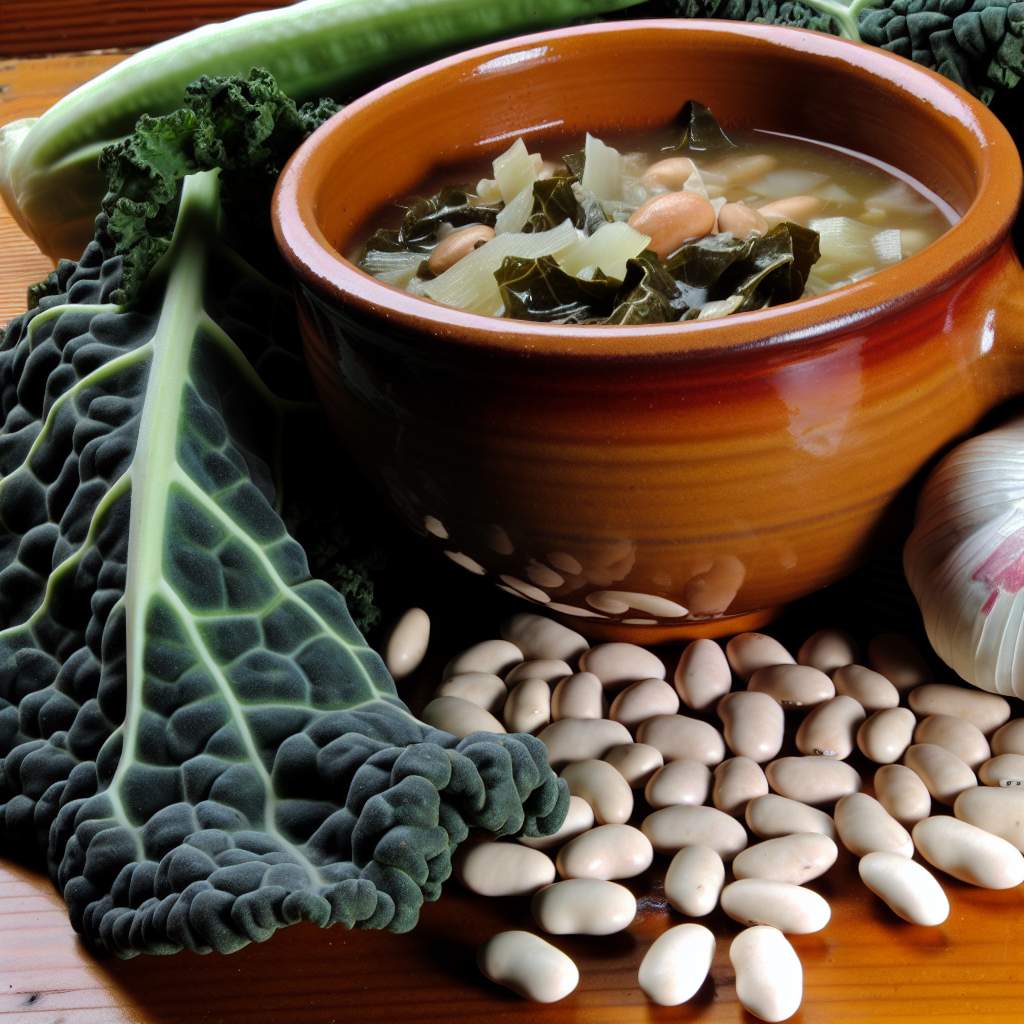There’s something magical about a soup that tastes better the next day. Ribollita, which literally means “reboiled” in Italian, is the epitome of peasant wisdom transformed into culinary genius. This hearty Tuscan soup, brimming with kale, white beans, and day-old bread, tells the story of resourceful Italian grandmothers who refused to let anything go to waste. What began as a way to stretch leftovers has become one of Tuscany’s most beloved comfort foods—a thick, luxurious potage that warms both body and soul during the chilly months.
My version of ribollita stays true to its humble roots while delivering layers of flavor that develop and deepen as it sits. The earthy kale melts into creamy beans, while chunks of bread dissolve slightly, thickening the broth to a velvety consistency that clings to your spoon. A finishing drizzle of peppery Tuscan olive oil transforms this peasant dish into something worthy of royalty. Perfect for meal prep, this soup actually improves over time, making it ideal for busy weeknights when you need nourishment without fuss.
The beauty of ribollita lies not just in its incredible flavors but in its forgiving nature. This is not a recipe that demands precision—it welcomes adaptation based on what’s in your pantry or garden. The key components remain constant: cavolo nero (Tuscan kale) with its distinctive dinosaur-like texture, creamy cannellini beans, aromatic vegetables, and stale bread that gives the soup its characteristic thickness.
Traditionally, ribollita was made after a meal of soup (often minestrone) with leftover bread mixed in. The next day, it would be “reboiled” (hence the name), with each reheating concentrating the flavors. This intentional layering of taste is what makes ribollita so extraordinary—it’s designed to improve with time, the flavors marrying and deepening with each gentle reheating.
Ingredients
- 3 tablespoons extra virgin olive oil, plus more for drizzling
- 1 large onion, diced
- 2 medium carrots, diced
- 2 celery stalks, diced
- 3 garlic cloves, minced
- 1 teaspoon dried thyme
- ½ teaspoon red pepper flakes (optional)
- 1 bay leaf
- 1 large bunch Tuscan kale (cavolo nero), stems removed and leaves chopped
- 1 15-oz can diced tomatoes
- 2 15-oz cans cannellini beans, drained and rinsed (or 3 cups cooked from dried)
- 6 cups vegetable broth
- 1 parmesan rind (optional, omit for vegetarian version)
- ½ loaf day-old crusty bread, torn into 1-inch pieces (about 4 cups)
- Sea salt and freshly ground black pepper, to taste
- Freshly grated Parmesan cheese, for serving (optional)
Instructions
1. In a large, heavy-bottomed pot or Dutch oven, heat the olive oil over medium heat. Add the onion, carrots, and celery with a pinch of salt. Sauté for 8-10 minutes until the vegetables have softened but not browned, stirring occasionally.
2. Add the garlic, thyme, red pepper flakes (if using), and bay leaf. Cook for another minute until fragrant, stirring constantly to prevent the garlic from burning.
3. Add the diced tomatoes and stir, scraping up any flavorful bits from the bottom of the pot. Cook for 2-3 minutes until the tomatoes start to break down.
4. Add the kale in batches, stirring until it wilts enough to add more. Once all the kale is wilted, add the cannellini beans, vegetable broth, and Parmesan rind if using. Bring to a gentle boil, then reduce heat to maintain a simmer.
5. Simmer the soup, partially covered, for about 30 minutes, stirring occasionally. The kale should become very tender and the flavors should meld together beautifully.
6. Remove the bay leaf and Parmesan rind (if used). Taste and adjust seasoning with salt and pepper.
7. Add the torn bread pieces to the soup, stir well, and cook for another 5-10 minutes until the bread begins to break down and thicken the soup. If the soup becomes too thick, add a little more broth or water to reach your desired consistency.
8. Remove from heat and let the ribollita rest for at least 20 minutes before serving. This resting period is crucial as it allows the flavors to further develop and the texture to reach its perfect consistency.
9. To serve, ladle the soup into bowls and finish with a generous drizzle of high-quality extra virgin olive oil and freshly grated Parmesan cheese if desired.
The Art of Reheating: Making True Ribollita
While delicious on the first day, ribollita reaches its pinnacle of flavor on day two or three. To truly make ribollita (“reboiled”), allow the soup to cool completely, then refrigerate overnight. The next day, gently reheat the soup over medium-low heat, stirring occasionally and adding a splash of water or broth if needed to loosen it up. The reheating process melds the flavors even further, creating a deeper, more complex taste experience that’s worth the wait.
Tips for the Perfect Ribollita
Use Tuscan kale (cavolo nero) if you can find it, as its robust texture stands up beautifully to the long cooking and reheating process. Regular curly kale makes a good substitute if needed. The bread should ideally be an unsalted, sturdy Tuscan-style loaf, but any good quality sourdough or country bread will work well. Just make sure it’s a day or two old—fresh bread will become too soggy.
Don’t rush the initial soffritto (the sautéed onion, carrot, and celery base). This foundational step builds essential flavor, so give it time to soften and develop. If you’re planning ahead, consider cooking your own beans from dried instead of using canned. The resulting broth from cooking the beans makes an excellent base for the soup with a depth of flavor that can’t be matched.
Finally, never skimp on the olive oil finish. A generous drizzle of your best extra virgin olive oil just before serving isn’t merely garnish—it’s an essential component that adds a peppery, fruity layer that elevates the entire dish.
Seasonal Variations
While traditional ribollita is a cold-weather dish, you can adapt it throughout the year. In spring, add fresh peas or tender young greens along with the kale. Summer versions might include a handful of diced zucchini or yellow squash added with the carrots. Early fall brings the option to add a diced fennel bulb to the soffritto for a subtle anise note that pairs beautifully with the beans.
This rustic Tuscan ribollita isn’t just a recipe—it’s a philosophy of cooking that values patience, simplicity, and the magic that happens when humble ingredients are given time to harmonize. Whether you’re serving it as a satisfying weeknight dinner or as the star of a casual gathering, this soup offers a taste of Tuscan tradition that resonates across cultures and generations. Buon appetito!

